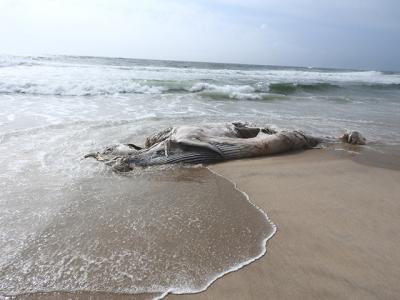Whales Wash Ashore

Two dead whales washed ashore this week, one in Amagansett on Monday, and the other in East Hampton Village yesterday, where a dead dolphin also was found at around the same time. Both whales, awash in the surf, were badly decomposed and seemed to be part of an “unusual mortality event” for whales along the Atlantic Coast.
Many dolphins had been seen by beachgoers last weekend between Montauk and Amagansett. The dead dolphin was found farther west along the shore, near the jetty at Main Beach.
A break in the rain on Tuesday allowed a team from the Atlantic Marine Conservation Society to perform a necropsy on the Amagansett whale, a minke, which washed ashore at Indian Wells Beach on Monday. It was 18.7 feet long, and the 11th large whale the organization has responded to in New York waters this year. A severely decomposed humpback whale washed up on Napeague in July.
The East Hampton whale, which was larger, “was fairly decomposed and missing many internal organs, including the reproductive organs, therefore the sex could not be determined,” the conservation society said in a statement Tuesday evening. The Town of East Hampton removed the carcass from the beach.
“Stranding investigations on all marine mammals and sea turtles are an important part of our conservation work as it provides valuable insight into the health of various species and what threats they face in our waters,” said Kimberly Durham, the society’s necropsy program director. “Though a definitive cause of death could not be determined during the necropsy our team conducted for this animal today, samples were taken and sent to a pathologist.” Pathology results may take several months to come back.
Someone walking on the beach in East Hampton after the rain let up yesterday reported the second decomposed whale, east of Old Beach Lane, to East Hampton Village police. It may be tomorrow or Friday before the organization can get a team to East Hampton for a necropsy. Though photographs were sent to the conservation society, its biologists said they could not identify the species until they saw it firsthand because of the decomposition, according to Rachel Bosworth, a spokeswoman.
There is an “unusual mortality event” for minke and humpback whales along the Atlantic Coast, the organization said. Biologists across the Northeast are working to uncover the reasons for the increased strandings. In 2017, there were 14 large whale strandings in New York and in previous years the numbers have ranged between four and eight, Ms. Bosworth said.
“In general, strandings have increased over the years but could be due to a number of reasons including increases in population numbers and also an awareness of these animals that have led people to report strandings,” Ms. Bosworth wrote in an email. “More animals could be coming to shore as well due to currents. However, these causes require research, which is an ongoing effort.”
The organization continues to ask that the public report live and dead marine mammal and sea turtle strandings immediately by calling the New York State Stranding Hotline at 631-369-9829. The public can also report sightings by emailing [email protected].
The organization also said it was proud to support the Shinnecock Nation, whose members honored their heritage Monday evening after the Amagansett whale washed up. Shane Weeks of the Shinnecock Nation performed a traditional ceremony for the whale, known as a podtap by the Shinnecocks. Mr. Weeks has been to nearly every whale beaching on Long Island for the last several years to perform the ceremony, the conservation society said.
“These events hold great cultural value to my people,” Mr. Weeks said in the organization’s statement. “The whales were also one of the staple foods for the indigenous people in the New England area historically. Our whaling canoes could hold almost 100 people. This connection is still acknowledged to this day.”
